Furnishing Your Period Encampment
Boxes and Chests
Perhaps the most basic and fundamentally useful piece of kit for a reenactor is the six-board chest. In a pinch this can double as a bench, and it has much to recommend it over plastic tubs. In its simplest form, the boards simply butt one another, but you'll get a more weather-tight box if you rabbet the edges. If you nail strips across the bottom, it will keep the bottom off the ground and lessen the effects of mud, wet grass, etc. If you're not experienced in woodworking, a six-board box is a good beginner's project.
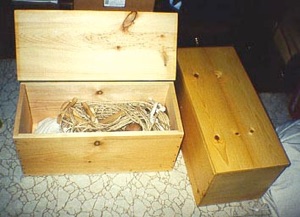

These examples are a bit more complex, and resemble some of the chests excavated from the wreck of the Tudor warship The Mary Rose.
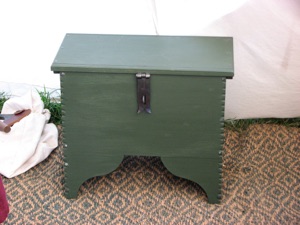

More recently I came up with a design for a large knock-down chest to hide our reenactment sins (ice chests and the like). You can read about it here.

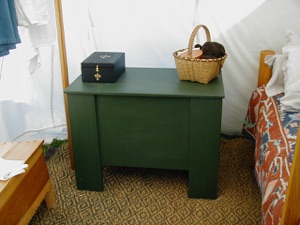
Benches
The stake-leg bench is very simple and appropriate for most parts of Europe through the Middle Ages and Rennaisance. There isn't much to them: Take a stout board and bore four holes at least 1-inch in diameter (and splaying slightly outward both front-to-back and side-to-side). Rip the legs from a board of similar thickness and carve round tenons to fit the holes. To make it more secure, notch the end of each tenon and insert a wedge to hold it. For 3 dollars worth of lumber and an hour of effort, you have a entirely authentic piece of medieval furniture, fit for peasants on up.


Here's one I knocked out one afternoon at Pennsic
with wood off the firewood pile.

Trestle Tables
The trestle table is a bit more complicated than a bench, but once you master the mortise and tenon joint, they're relatively easy. A trestle table very similar to this one is illustrated in Jost Amman's Book of Trades, c. 1568. This example is made from hemlock and fir (cheap wood from the home center!) and has held up well. For construction notes, see Roy Underhill's book The Woodwright's Apprentice.
For information on making the tusk-tenon joints that allow the trestle to knock-down flat, click here.


Here is another trestle table with a poplar trestle and a birch plywood top. The edges have been banded with thin pine to hide the ply.

Chairs
Stools and benches are all well and fine, but for a week of camping it's nice to have something with a little more support. I'm a fan of turned furniture (if you couldn't tell), it being surprisingly easy to make and light to carry.
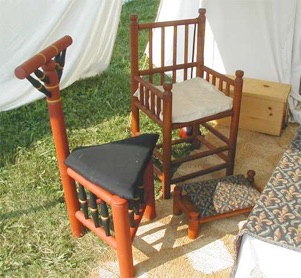
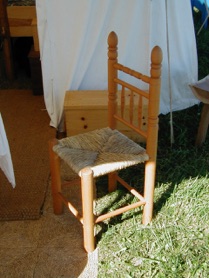
I did not build this example of a period X-chair, but the construction is very straightforward. See Roy Underhill's book "The Woodwright's Eclectic Workshop" for a discussion on how to build this chair.
A Field Bed

This project proves the danger of making a "prototype" too well; it's worn well over several years of use, and it's mostly my own embarrassment at my early work that makes me want to replace it with something more recognizably period.
A truly period field bed would most likely use a rope suspension. This example uses the slats left over from an old futon frame. The slats are actually grouped in three "pallets," each pallet held together by three battens. This eliminates the need for a third rail down the middle and provides for a very rigid platform.

The corner posts are common 4 by 4's, each hewn down to a octogon using handsaw, mortising chisel, and mallet. The head and foot boards are tenoned into the posts with glued pegs. Tusk tenons hold the rails in place. Leave sufficient height so you can use the space beneath for out-of-sight storage.
A friend of mine recently made a much more attractive version out of oak. In his design, the head/foot boards as well as the rails are tusk-tenoned, making it possible to completely disassemble the frame.

Here are a few pictures of what our camp has looked like over the years...


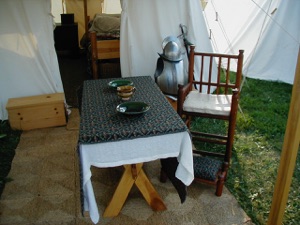


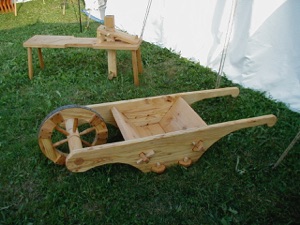
For most reenactment activities, there is always a tradeoff between having historically accurate equipment (or some approximation thereof), and having to load, transport, unload, setup, takedown, reload, and take home that said equipage. While some medieval and Renaissance furniture was made to be transportable, much of it was large, heavy, and not intended to be taken apart on a regular basis. My idea of camp furniture is probably a little different than most; of course a four-post chair is necessary for a camp! But don't be intimidated; you can make very period-appropriate furniture with few tools or experience. The simple stake-leg bench is appropriate throughout the Middle Ages and Renaissance, and you can make one in an afternoon.
Here are a few approximations of period furniture I've put together over the years for reenactment events. Most are relatively cheap and easy to make, some less so. For other furniture ideas, see my Project Album.
Copyright 2019, Thomas Rettie.